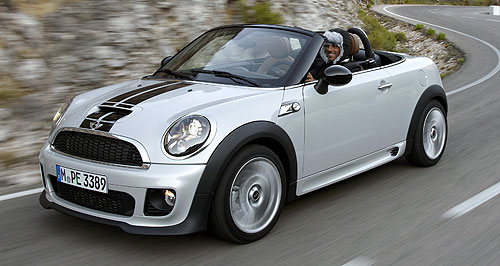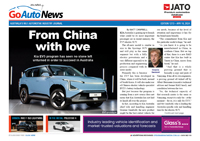Make / Model Search
Future models - Mini - RoadsterMini Roadster to cost about $41k in OzPocket rocket: Mini’s Roadster promises a go-kart driving experience thanks to a stiff body structure, low centre of gravity, improved weight distribution – and, of course, open-top thrills. Simultaneous Q1 launch confirmed for Mini Roadster, Coupe as official pics emerge31 Oct 2011 THE first official pictures and details have emerged of a Roadster counterpart to Mini’s ‘helmet head’ Coupe – and both have been confirmed for a late first-quarter launch in Australia next year. Mini Australia PR and corporate communications manager Piers Scott could not yet confirm local pricing, but told GoAuto the Coupe will attract a maximum $5000 premium over the equivalent hatch, with Roadsters priced about $2000 higher again, suggesting a circa-$41,000 opening price for the Roadster. That pricing places both of the style-led, driver-focussed two-seat Minis into rare territory, undercutting the Mazda MX-5 roadster (from $44,265) and Peugeot RCZ coupe ($55,990). Apart from the lack of rear seats and a 20mm lower overall height, the Roadster is differentiated from the Mini cabriolet by its steeply-angled windscreen pillars that meet a coupe-shaped black fabric roof, which stows flush with an extended rear deck behind the fixed stainless steel rollover bars – as opposed to being folded down behind the seats. Mini also promises a new level of kart-like handling from its first two-seat convertible thanks to a stiffer body structure, lower centre of gravity (aided by the manually-operated fabric roof) and front-biased weight distribution to improve traction. Like the Coupe, an active rear spoiler – claimed to provide up to 40kg of extra downforce at high speed – can be manually activated via a button on the windscreen frame, or automatically rises when the car exceeds 80km/h, returning to a flush position when the speed drops below 60km/h.  The Roadster’s cockpit is based on the standard Mini hatch and cabriolet, apart from the option – as with the Coupe – of piped sports seats in Toffy-coloured leather or black with beige perforations. The Roadster’s cockpit is based on the standard Mini hatch and cabriolet, apart from the option – as with the Coupe – of piped sports seats in Toffy-coloured leather or black with beige perforations.Like its Coupe sibling, in place of a rear bench is a small storage area with load-through hatch that can be accessed from the cockpit. The Roadster’s boot offers 240 litres of luggage space, 40 litres less than the coupe but still a useful 80 litres more than the hatch and 70 more than the cabriolet. Mr Scott said the extra luggage space would make the sportier Roadster or Coupe a more practical solution for customers who seldom use the rear seats of the standard hatch or cabriolet. He added that the price premium was worth it for their design, improved roadholding and “go-kart driving sensation”. “I would say the price premium is justified in what is a striking concept and a very dynamic drive,” said Mr Scott, who suggested that the sporty Minis could even compete with the Audi TT. Pricing for the entry-level 1.8-litre TT coupe starts a clear $10,000 north of the likely price of a top-spec John Cooper Works (JCW) Coupe variant, with the TT Roadster priced even higher. However, dabbling in the traditionally wallet-busting Mini options list could easily make up the difference. Roadsters will get the full complement of standard BMW safety aids including electronic stability control, traction control, anti-lock brakes with electronic brakeforce distribution, cornering brake control, brake and hill-start assist and tyre pressure monitoring. Dual front airbags plus side head-thorax airbags and seatbelt pre-tensioners with force limiters will also be standard, along with power-adjustable side mirrors, parking sensors, air-conditioning and an MP3-compatible CD audio system with auxiliary input. JCW variants will get the torque-steer-reducing electronic differential lock control (optional on less powerful variants), an aerodynamic bodykit claimed to optimise airflow, the option of Chilli Red trim interior trim strips, an upgraded stereo and a dash-mounted Sport button that sharpens the steering and throttle response. Stiffening measures have been applied to the Roadster body to reduce the effect of removing the roof, while reinforced sills and windscreen frame improve the strength of the passenger cell. Which of the four engine options will be imported to Australia is yet to be announced. However, all but the manual-only JCW will have the option of either a six-speed manual or six-speed automatic transmission. The 1.6-litre four-cylinder petrol engine comes in three states of tune, opening with the 90kW/160Nm naturally-aspirated Cooper that consumes 5.7 litres of fuel per 100 kilometres, outputs 133 grams of CO2 per kilometre and has a 0-100km/h time of 9.2 seconds. Next up is the 135kW/260Nm turbocharged Cooper S, capable of 0-100km/h in 7.0 seconds, with fuel consumption and CO2 output of 6.0L/100km and 138g/km. Topping the petrol line-up is the JCW flagship, which squeezes 155kW and up to 280Nm from the little four-pot to provide 0-100 in 6.5 seconds, with eco figures of 7.3L/100km and 169g/km. A nod to frugality comes in the shape of the 2.0-litre diesel-powered Cooper SD, which returns 4.5L/100km and emits 118g/km while producing 105kW at 4000rpm and a hefty 305Nm of torque between 1750rpm and 2700rpm. Production of the Roadster will take place at Mini’s production facility just outside Oxford in the UK, alongside the hatch, cabriolet, Clubman wagon and Coupe.  Read more21st of June 2011  Mini whips covers off new CoupeOfficial pictures of Mini’s new Coupe released ahead of 2011 Australian launch7th of June 2011  Full details: Mini Coupe confirmed for OzComplete engine line-up revealed for new Mini Coupe before its late-2011 releaseAll future models Alfa Romeo Alfa Romeo Abarth Abarth Alpine Alpine Alpina Alpina Audi Audi Aston Martin Aston Martin BMW BMW Bentley Bentley Chery Chery Brabham Brabham Chrysler Chrysler Chevrolet Chevrolet Cupra Cupra Citroen Citroen DS DS Dodge Dodge Fiat Fiat Ferrari Ferrari Foton Foton Ford Ford Great Wall Great Wall FPV FPV Haval Haval GWM GWM Honda Honda Holden Holden Hummer Hummer HSV HSV Infiniti Infiniti Hyundai Hyundai Jaguar Jaguar Isuzu Isuzu Kia Kia Jeep Jeep Land Rover Land Rover Lamborghini Lamborghini Lexus Lexus LDV LDV Mahindra Mahindra Lotus Lotus Mazda Mazda Maserati Maserati Mercedes-AMG Mercedes-AMG McLaren McLaren MG MG Mercedes-Benz Mercedes-Benz Mitsubishi Mitsubishi Mini Mini Opel Opel Nissan Nissan Peugeot Peugeot Pagani Pagani Proton Proton Porsche Porsche Renault Renault Ram Ram Rover Rover Rolls-Royce Rolls-Royce Skoda Skoda Saab Saab SsangYong SsangYong Smart Smart Suzuki Suzuki Subaru Subaru Toyota Toyota Tesla Tesla Volvo VolvoMotor industry news |
Click to shareMini modelsResearch Mini All future models Alfa Romeo Alfa Romeo Abarth Abarth Alpine Alpine Alpina Alpina Audi Audi Aston Martin Aston Martin BMW BMW Bentley Bentley Chery Chery Brabham Brabham Chrysler Chrysler Chevrolet Chevrolet Cupra Cupra Citroen Citroen DS DS Dodge Dodge Fiat Fiat Ferrari Ferrari Foton Foton Ford Ford Great Wall Great Wall FPV FPV Haval Haval GWM GWM Honda Honda Holden Holden Hummer Hummer HSV HSV Infiniti Infiniti Hyundai Hyundai Jaguar Jaguar Isuzu Isuzu Kia Kia Jeep Jeep Land Rover Land Rover Lamborghini Lamborghini Lexus Lexus LDV LDV Mahindra Mahindra Lotus Lotus Mazda Mazda Maserati Maserati Mercedes-AMG Mercedes-AMG McLaren McLaren MG MG Mercedes-Benz Mercedes-Benz Mitsubishi Mitsubishi Mini Mini Opel Opel Nissan Nissan Peugeot Peugeot Pagani Pagani Proton Proton Porsche Porsche Renault Renault Ram Ram Rover Rover Rolls-Royce Rolls-Royce Skoda Skoda Saab Saab SsangYong SsangYong Smart Smart Suzuki Suzuki Subaru Subaru Toyota Toyota Tesla Tesla Volvo VolvoMotor industry news |










Facebook Twitter Instagram